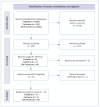Can Orthodontic Adhesive Systems Inhibit the Formation and Development of White Spot Lesions During Fixed Orthodontic Treatment? A Systematic Review
- PMID: 39397759
- PMCID: PMC11748040
- DOI: 10.3290/j.jad.b5781299
Can Orthodontic Adhesive Systems Inhibit the Formation and Development of White Spot Lesions During Fixed Orthodontic Treatment? A Systematic Review
Abstract
Purpose: This study aims to assess whether orthodontic bonding systems prevent orthodontic-induced white spot lesions (OIWSLs), exploring efficacy and identifying associated factors through a comprehensive systematic review of existing evidence.
Materials and methods: The study complied to Preferred Reporting Items for Systematic Reviews and Meta-Analyses (PRISMA) guidelines. Two evaluators screened records, and data were extracted on orthodontic bonding systems, outcomes, and participant characteristics from PubMed/MEDLINE, Cochrane Library, and EM Premium. The search equation focused on white spot lesions and orthodontic bonding. Only in-vivo studies and clinical trials on humans were included, while in-vitro studies were excluded. The risk of bias was assessed using Cochrane's RoB2 tool for RCTs and ROBINS-I tool for non-randomized studies, evaluating key domains related to bias.
Results: The systematic review, including 12 articles with 550 participants and 2,000 teeth, revealed that bonding with nanoparticles of nCaF2-primer and amorphous calcium phosphate-containing adhesives effectively reduced WSLs. In contrast, one-step adhesive without primer (GC Ortho Connect™) was associated with higher and more severe WSLs. Fluoride-releasing primers (Opal Seal™ and Clearfil™) did not exhibit an advantage in demineralization reduction. The inclusion of TiO2 nanoparticles in two studies yielded conflicting results on antibacterial effects.
Discussion: Various nanoparticles incorporated into adhesives or primers exhibit promise in preventing white spot lesions in fixed orthodontic treatment. However, the used evaluation methods, such as clinical examinations or advanced imaging, significantly impact result interpretation. The effectiveness of orthodontic adhesives in preventing WSLs should balance between biocompatibility, bond strength and demineralization control tailored to patient-specific needs.
Keywords: enamel demineralization; fixed orthodontics; orthodontic adhesive; prevention; white spot lesion.
References
-
- Aimutis WR. Bioactive properties of milk proteins with particular focus on anticariogenesis. J Nutr. 2004;134:989S–995S. - PubMed
-
- Al Maaitah EF, Adeyemi AA, Higham SM, Pender N, Harrison JE. Factors affecting demineralization during orthodontic treatment: a post-hoc analysis of RCT recruits. Am J Orthod Dentofacial Orthop. 2011;139:181–191. - PubMed
-
- Al Tuma RR, Yassir YA. Effect of calcium fluoride nanoparticles in prevention of demineralization during orthodontic fixed appliance treatment: a randomized clinical trial. Eur J Orthod. 2023;45:122–132. - PubMed
-
- Al Tuma RR, Yassir YA. Evaluation of a newly developed calcium fluoride nanoparticles-containing orthodontic primer: an in-vitro study. J Mech Behav Biomed Mater. 2021;122:104691. - PubMed
Publication types
MeSH terms
Substances
LinkOut - more resources
Full Text Sources
Medical
Miscellaneous


